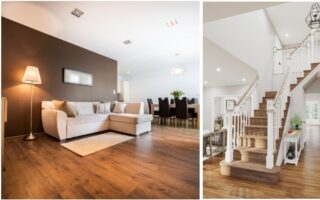When it comes to painting a wood floor, the options are endless. From bright and bold colors to subtle neutrals, choosing the right paint color can truly transform the look and feel of your space. Before diving into this project, consider factors such as lighting, room size, and existing decor to ensure you select a color that complements your style.
Properly preparing and painting a wood floor is critical to achieving long-lasting results. Clean and sand the surface thoroughly before applying paint for a smooth finish. Regularly maintaining painted wood floors by cleaning up spills promptly and using protective pads on furniture legs can help preserve their beauty for years.
If you’re not keen on painting your wood floors, there are alternative options, like staining or refinishing them to give them a fresh new look without covering up the natural beauty of the wood grain.
Whether you opt for a classic white hue or go bold with a pop of color, painting your wood floors can breathe new life into any room. With careful consideration of factors like lighting and maintenance needs, you can create a stunning and durable flooring solution that reflects your style.
The benefits of painting a wood floor

Painting a wood floor comes with a myriad of benefits that go beyond just aesthetics. One significant advantage is its added protection against scratches, stains, and daily wear. By sealing the wood surface with paint, you can prolong your floors’ lifespan and keep them pristine for years to come.
Painting allows you to customize your space according to your style preferences and design vision. Whether you opt for a bold statement color or a subtle, neutral shade, painting gives you endless possibilities to enhance your home’s overall look and feel.
Another perk of painted wood floors is the ease of maintenance they offer. Unlike traditional wood finishes that require regular refinishing, painted floors are relatively low-maintenance and can be easily cleaned with a damp mop or cloth. This convenience makes them ideal for busy households seeking beauty and practicality in their flooring choice.
Factors to consider before choosing a paint color
When deciding on a paint color for your wood floor, several factors must be considered. First and foremost, think about the overall style and theme of the room where the floor is located. The color should complement the decor and furniture to create a cohesive look.
Consider the natural lighting in the room as well. Dark colors make a space feel smaller, while light colors help brighten a room. Please note how much sunlight enters the area throughout the day to choose a color that will enhance its natural brightness.
Consider durability, too – high-traffic areas may benefit from darker shades that hide dirt and scuffs better than lighter colors. If you have pets or children, consider opting for more forgiving tones that won’t show every scratch or stain.
Top color options for wood floors

When choosing a color for your wood floors, the options are endless. One popular choice is a classic white paint that can brighten up any room and make it feel more spacious. Consider a deep navy or charcoal gray for a dramatic statement if you’re looking for something bold.
For a more natural look, opt for a light oak or honey-brown stain that enhances the beauty of the wood grain. Gray tones have been trending lately and can give your space a modern and sleek vibe. On the other hand, dark ebony or espresso colors bring warmth and richness to the room.
How to properly prepare and paint a wood floor
First things first, before diving into painting your wood floor, you need to prepare it properly. Remove any dirt, dust, or debris from the surface by thoroughly cleaning it. Sanding the floor is essential to create a smooth and even base to which the paint can adhere.
Once the floor is clean and sanded, applying a primer specifically designed for use on wood surfaces is crucial. This will help the paint stick better and ensure a long-lasting finish. Choose a high-quality paint that is durable and suitable for floors.
When it comes time to paint the floor, use even strokes in the direction of the wood grain for a professional look. Multiple thin coats are better than one thick coat, providing better coverage and durability.
Maintenance tips for painted wood floors
Maintaining painted wood floors is essential to keep them looking fresh and vibrant for years to come. Regular sweeping or vacuuming can help prevent dirt and debris from scratching the surface. For a deeper clean, damp mop the floor with a mild cleaner suitable for painted surfaces.
Avoid harsh chemicals or abrasive cleaning tools that could damage the paint finish. Place felt pads under furniture legs to prevent scratches when moving items around. High-heeled shoes can also cause damage, so consider wearing soft-soled shoes indoors.
In high-traffic areas, it’s a good idea to periodically touch up any scuffs or chips in the paint to maintain the floor’s appearance. If you notice any water damage or peeling paint, address it promptly to prevent further deterioration.
Alternative options for updating wood floors
If painting your wood floor isn’t your style, alternative options exist to update its look and feel. Staining the wood for a more natural finish enhances grain patterns and color variations. Stains come in various shades, allowing you to customize the appearance of your floor to match your aesthetic preferences.
Another option is refinishing the wood by sanding the surface to remove any existing finish or imperfections. This process can bring out the natural beauty of the wood while allowing you to stain or seal it.
For a more unconventional approach, consider adding stenciled designs or patterns onto your wood floor for a unique and personalized touch. This creative option allows you to showcase your style and make bold statements in any room.
Incorporating area rugs or runners over certain sections of the wood floor can add warmth, texture, and visual interest to the space without covering the entire surface. Mixing and matching different rug styles and sizes allows you to create distinct zones within a room while protecting high-traffic areas from wear and tear.




